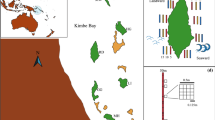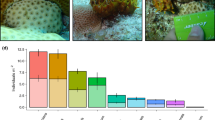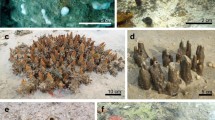Abstract
The nature or structure of competition within communities has been a dynamic area of practical and theoretical research for a number of decades. Certain components of some communities have proved hard to incorporate within such studies; in marine benthic work this has included the sponges. In this study, intra- and inter-phyletic interactions involving sponges (7,817 in total) were studied on 125 rocks (ranging in surface area from 10 to 2,438 cm2) at a site experiencing low disturbance levels at Lough Hyne Marine Nature Reserve, Co. Cork, Ireland. The outcomes of sponge-sponge (intra-phyletic) interactions were significantly different in both outcome and structure to those involving sponges and representatives of other phyla. Typically sponge-sponge competition resulted in a much higher number of tied outcomes than did inter-phyletic encounters. Sponges over-grew all groups of organisms with the exception of some cnidarians and ascidians. The morphology of any sponge species (thickness in most cases) was important in determining the outcome of intra-phyletic, but not inter-phyletic, interactions. Sponges which exhibited thick (>2 mm) crusts were, in the majority of interactions, superior competitors compared to the thin (<1 mm) crusts. However, the method used to rank species (i.e. wins:loss or wins:total ratio) made a significant difference to the ranking of sponge competitors. The transitivity of the sponge assemblage investigated was calculated using the index formulated by Tanaka and Nandakumar (1994) as 0.23, indicating the assemblage to be organised as a network rather than a hierarchical system. We suggest this network of principally tied outcomes (due to standoffs) may be maintained in part by chemical interaction. However, in the absence of disturbance, the network is more likely to be mediated through processes of growth and regression of tissues during summer and winter months respectively.

Similar content being viewed by others
References
Aerts LAM (2000) Dynamics behind standoff interactions in three reef sponge species and the coral Montastrea cavernosa. PSZN Mar Ecol 21:191−204
Aerts LAM, van Soest RWM (1997) Quantification of sponge/coral interactions in a physically stressed reef community, NE Columbia. Mar Ecol Prog Ser 148:125−134
Ayling AL (1983) Factors affecting the spatial distributions of thinly encrusting sponges from temperate waters. Oecologia 60:412−418
Barnes DKA (1999) High diversity of tropical intertidal zone sponges in temperature, salinity and current extremes. Afr J Ecol 37:424−434
Barnes DKA, Dick MH (2000) Overgrowth competition between clades: implications for interpretation of the fossil record and overgrowth indices. Biol Bull 199:85−94
Barnes DKA, Rothery P (1996) Competition in encrusting Antarctic bryozoan assemblages: outcomes, influences and implications. J Exp Mar Biol Ecol 196:267−284
Barnes DKA, Rothery P, Clarke A (1996) Colonisation and development in encrusting communities from the Antarctic intertidal and sublittoral. J Exp Mar Biol Ecol 196:248−265
Barthel D (1989) Growth of the sponge Halichondria panicea in the North Sea habitat. Proc Euro Mar Biol Symp 21:23−30
Bassindale R, Davenport E, Ebling FJ, Kitching JA, Sleigh MA, Sloane JF (1957) The ecology of Lough Hyne Rapids with special reference to water currents. VI. Effects of the rapids on the hydrography of the South Basin. Ecology 45:879−900
Bell JJ, Barnes DKA (2000) The influence of bathymetry and flow regime on the morphology of sublittoral sponge populations at Lough Hyne MNR. J Mar Biol Assoc UK 80:707−718
Bell JJ, Barnes DKA (2001) A sponge diversity hotspot within a Marine Island. Hydrobiologia 440:55−64
Bell JJ, Barnes DKA (2002) Density, distribution and decline of two species of unattached demosponge. Sarsia 87:110−118
Bell JJ, Barnes DKA (2003) The relationship between sedimentation, flow rates, depth and time at Lough Hyne Marine Nature Reserve. Ir Nat J (in press)
Boury-Esnault N, Rützler K (1997) Thesaurus of sponge morphology. Smithson Contrib Zool 596
Buss LW (1976) Better living through chemistry: the relationship between allelochemical interactions and competitive networks. In: Harrison FW (ed) Aspects of sponge biology, Academic Press, New York, pp 315−327
Buss LW (1980) Competitive intransitivity and size frequency distributions of interacting populations. Proc Natl Acad Sci USA 77:5255−5259
Buss LW, Jackson JBC (1979) Competitive networks: nontransitive competitive relationships in cryptic coral reef environments. Am Nat 113:223−234
Connell JH (1961) The influence of interspecific competition and other factors on the distribution of the barnacle Chthamalus stellatus. Ecology 42: 710−723
Connell JH (1976) Competitive interactions and the species diversity of corals. In: Mackie GO (ed) The third international symposium on coelentrate ecology and behaviour. Plenum Press, New York,pp 51−58
Dayton PK (1971) Competition, disturbance and community organization: the provision and subsequent utilisation of space in a rocky intertidal community. Ecol Monogr 41:351−389
Dayton PK (1978) Observations of growth, dispersal and population dynamics of some sponges in McMurdo Sound, Antarctica. In: Levi C, Boury-Esnault N (eds) Sponge biology. Colloq Int CNRS 291:271−282
Elvin DW (1976) Seasonal growth and reproduction of an intertidal sponge, Haliclona permollis (Bowerbank). Biol Bull 151:108−125
Hildemann WH, Johnson IS, Jokiel PL (1978) Immunocompetence in the lowest Metazoan Phylum: transplantation immunity in sponges. Science 204:420−422
Huysecom J, Van de Vyver G, Braekman J-C, Daloze D (1990) Chemical defense in sponges from North Brittany. In: Rützler K (ed) New Perspectives in sponge biology. Smithsonian Institution Press, Washington D.C., pp 115–118
Jackson JBC (1979) Overgrowth competition between encrusting Cheilostome ectoprocts in a Jamaican reef environment. J Anim Ecol 48:805−824
Jackson JBC, Buss LW (1975) Allelopathy and spatial competition among coral reef invertebrates. Proc Natl Acad Sci USA 72:5160−5163
Johnson IS, Jokiel PL, Bigger CH, Hildemann WH (1981) The influence of temperature on the kinetics of allograft reactions in a tropical sponge and a reef coral. Biol Bull 160:280−291
Kaandorp JA (1999) Morphological analysis of growth forms of branching marine sessile organisms along environmental gradients. Mar Biol 134:295−306
Kay AM (1980) The organisation of sessile guilds on pier pilings. PhD thesis, University of Adelaide, Australia
Lang J (1973) Interspecific aggression by scleractinian corals 2. Why the race is not only to the swift. Bull Mar Sci 23:260−279
Lilly SJ, Sloane F, Bassindale R, Ebling FJ, Kitching JA (1953) The ecology of the Lough Hyne rapids with special reference to water currents. IV. The sedentary fauna of sublittoral boulders. J Anim Ecol 22:87−122
Lopez Gappa JJ (1989) Overgrowth competition in a assemblage of encrusting bryozoans settled on artificial substrata. Mar Ecol Prog Ser 51:121−130
Maldonado M (1998) Do chimeric sponges have improved chances of survival? Mar Ecol Prog Ser 164:301−306
Maldonado M, Uriz MJ (1992) Relationships between sponges and crabs: patterns of epibiosis on Inachus aguiarii (Decapoda: Majidae). Mar Biol 113:281−286
Maldonado M, Uriz MJ (1999) An experimental approach to the ecological significance of microhabitat-scale movement in an encrusting sponge. Mar Ecol Prog Ser 185:239−255
Maughan BC (2000) Ecology of encrusting epifauna in Lough Hyne Marine Nature Reserve, Co. Cork, Ireland. PhD Thesis, University College Cork, Ireland
Maughan BC, Barnes DKA (2000a) A 'minimum stress inflexion' in relation to environmental and biotic influences on the dynamics of subtidal encrusting communities. Hydrobiologia. 440:101−109
Maughan BC, Barnes DKA (2000b) Epilithic boulder communities of Lough Hyne, Ireland: the influences of water movement and sediment. J Mar Biol Assoc UK 80:767−776
Maughan BC, Barnes DKA (2000c) Seasonality of competition in early development of subtidal encrusting communities. PSZN Mar Ecol 21:205−220
Palumbi SR (1984) Tactics of acclimation: morphological changes of sponges in an unpredictable environment. Science 225:1478−1480
Palumbi SR (1986) How body plans limit acclimation: responses of a demosponge to wave force. Ecology 67:208−214
Pansini M, Pronzato R (1990) Observations on the dynamics of a Mediterranean sponge community. In: Rützler K (ed) New perspectives in sponge biology. Smithsonian Institution Press, Washington D.C., pp 404−415
Pawlik JR, Chanas B, Toonen RJ, Fenical W (1995) Defences of Caribbean sponges against predatory reef fish. I. Chemical deterrency. Mar Ecol Prog Ser 127:183−194
Picton BE (1991) The sessile fauna of sublittoral cliffs. In: Myers AA, Little C, Costello MJ, Partridge JC (eds) The ecology of Lough Hyne: proceedings of a conference 4–5th Sep 1990. Royal Irish Academy, Dublin, pp 139−142
Porter JW, Targett NM (1988) Allelochemical interactions between sponges and corals. Biol Bull 175:230−239
Proksch P (1994) Defensive roles for secondary metabolites from marine sponges and sponge-feeding nudibranchs. Toxicon 32:639−655
Quinn JF (1982) Competitive hierarchies in marine benthic communities. Oecologia 54:129−135
Rubin JA (1982) The degree of intransitivity and its measurement in a assemblage of encrusting cheliostome Bryozoan. J Exp Mar Biol Ecol 60:119−128
Russ GG (1982) Overgrowth in a marine epifaunal community: competitive hierarchies and competitive networks. Oecologia 53:12−19
Rützler K (1970) Spatial competition by Porifera: solution by epizoism. Oecologia 5:85−95
Sarà M (1970) Competition and cooperation in sponge populations. Symp Zool Soc Lond 25:273−284
Schmidt GH, Warner GG (1986) Spatial competition between colonial ascidians: the importance of stand-off. Mar Ecol Prog Ser 31:73–96
Soest RMW van, Weinberg S (1980) A note on the sponges and octocorals from Sherkin Island and Lough Ine, Co. Cork. Ir Nat J 20:1−15
Soest RMW van, Guiterman JD, Sayer MS (1981) Sponges from Roaringwater Bay and Lough Ine. J Sherkin Island 12:35−49
Stone AR (1970) Growth and reproduction of Hymeniacidon perleve (Montagu) (Porifera) in Langstone Harbour, Hampshire. J Zool 161:443−459
Swearingen DC III, Pawlik JR (1998) Variability in the chemical defense of the sponge Chondrilla nucula against predatory reef fishes. Mar Biol 131:619−627
Tanaka M, Nandakumar K (1994) Measurement of the degree of intransitivity in a community of sessile organisms. J Exp Mar Biol Ecol 182:85−95
Turner SJ, Todd CD (1994) Competition for space in encrusting bryozoan assemblages: the influence of encounter angle, site and year on outcome variability. J Mar Biol Assoc UK 74:603−622
Turon X, Becerro MA, Uriz MJ (1996) Seasonal patterns of toxicity in the benthic invertebrates: the encrusting sponge Crambe crambe (Peocilosclerida). Oikos 75:33−40
Vicente VP (1990) Overgrowth activity by the encrusting sponge Chondrilla nucula on a coral reefs in Puerto Rico. In: Rützler K (ed) New perspectives in sponge biology. Smithsonian Institution Press, Washington D.C., pp 436−442
Wulff JL (1997) Mutualisms among species of coral reef sponges. Ecology 78:146−159
Acknowledgements
The authors wish to thank Declan O' Donnell from the Irish Wildlife Service (Duchas) for granting permits for research at Lough Hyne (permit number R04/00). The authors would also like to express their gratitude to John Bohane, the caretaker of Lough Hyne, for his dedication to Lough Hyne over the years. Forbait Ireland (Enterprise Ireland) also provided financial assistance.
Author information
Authors and Affiliations
Corresponding author
Additional information
Communicated by J.P. Thorpe, Port Erin
Rights and permissions
About this article
Cite this article
Bell, J.J., Barnes, D.K.A. The importance of competitor identity, morphology and ranking methodology to outcomes in interference competition between sponges. Marine Biology 143, 415–426 (2003). https://doi.org/10.1007/s00227-003-1081-0
Received:
Accepted:
Published:
Issue Date:
DOI: https://doi.org/10.1007/s00227-003-1081-0




